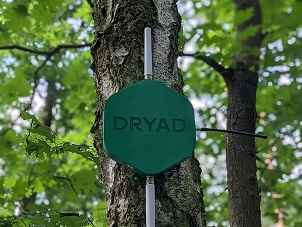Dryad Networks - Sensors against wildfires

The Eberswalde-based company Dryad has developed the innovative Silvanet system, consisting of gas sensors and solar-powered long-range radio infrastructure, in order to be able to detect forest fires at an early stage and thus protect the environment effectively and sustainably, and also to open up new business potential.
Wildfires are an increasing danger for humans and animals and contribute significantly to the acceleration of climate change. Conventional forest fire detection systems (mostly cameras or satellites) usually detect fires too late. As a result, some devastating large-scale fires can no longer be prevented, or only requiring considerable effort. The aim of Dryad’s project was therefore to develop a supplementary sensor system for early detection of forest fires, which, through continuous measurement of environmental data, detects forest fires already during the smouldering phase within 60 minutes and thus drastically reduces the response time in the event of a disaster. The system enables rapid and cost-effective extinguishing to prevent the spread of a forest fire and the often considerable consequential damage. The project was supported in the research and development phase of the system with funding from the European Regional Development Fund (ERDF).
Sensor network with long-range radio technology
The Silvanet includes a large-scale wireless sensor network, which links the sensors via a radio network similar to the Internet of Things. Initially, small solar-powered and low-cost sensors are placed on trees throughout the forest. The sensors can measure a variety of environmental parameters such as the outside temperature, the moisture of the soil and the air as well as the ozone concentration, the tree sap flow and the tree growth and thus constantly monitor the microclimate in the forest. The sensors work like an electronic nose that detects, classifies and transmits the most diverse odours and gas developments. Due to the composition of the soil, smouldering fires can “smell” differently depending on the type of forest. The artificial intelligence (AI) integrated into the sensors was specially trained for the smells in the target forest and is constantly learning in order to minimise false alarms. The data collected by the sensors is processed, analysed and monitored in a cloud-based online platform. If a smouldering fire is detected, the system sets off an alarm.
Research and development from Brandenburg
Dryad’s product not only promotes environmental protection in the forests, but also Brandenburg as a business location. By the end of 2022, the company already had 32 employees and was able to bring the sensors into mass production with a figure of 10,000 units. The forest fire sensors “Made in Germany” are in demand internationally and are already used worldwide.
For further information, visit de.dryad.net
Wildfires are an increasing danger for humans and animals and contribute significantly to the acceleration of climate change. Conventional forest fire detection systems (mostly cameras or satellites) usually detect fires too late. As a result, some devastating large-scale fires can no longer be prevented, or only requiring considerable effort. The aim of Dryad’s project was therefore to develop a supplementary sensor system for early detection of forest fires, which, through continuous measurement of environmental data, detects forest fires already during the smouldering phase within 60 minutes and thus drastically reduces the response time in the event of a disaster. The system enables rapid and cost-effective extinguishing to prevent the spread of a forest fire and the often considerable consequential damage. The project was supported in the research and development phase of the system with funding from the European Regional Development Fund (ERDF).
Sensor network with long-range radio technology
The Silvanet includes a large-scale wireless sensor network, which links the sensors via a radio network similar to the Internet of Things. Initially, small solar-powered and low-cost sensors are placed on trees throughout the forest. The sensors can measure a variety of environmental parameters such as the outside temperature, the moisture of the soil and the air as well as the ozone concentration, the tree sap flow and the tree growth and thus constantly monitor the microclimate in the forest. The sensors work like an electronic nose that detects, classifies and transmits the most diverse odours and gas developments. Due to the composition of the soil, smouldering fires can “smell” differently depending on the type of forest. The artificial intelligence (AI) integrated into the sensors was specially trained for the smells in the target forest and is constantly learning in order to minimise false alarms. The data collected by the sensors is processed, analysed and monitored in a cloud-based online platform. If a smouldering fire is detected, the system sets off an alarm.
Research and development from Brandenburg
Dryad’s product not only promotes environmental protection in the forests, but also Brandenburg as a business location. By the end of 2022, the company already had 32 employees and was able to bring the sensors into mass production with a figure of 10,000 units. The forest fire sensors “Made in Germany” are in demand internationally and are already used worldwide.
For further information, visit de.dryad.net

